Wernher von Braun was a pioneer rocket scientist and engineer. His first efforts were on behalf of Nazi Germany. Following World War II, he came to America, where his efforts led to the development of Explorer satellites, Jupiter, Jupiter-C, Pershing, Redstone and Saturn rockets, and Skylab, the world's first space station.
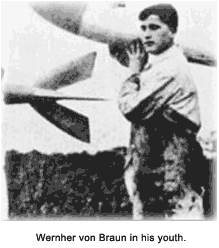 Von Braun was born on March 23, 1912, the second of three sons of the Baron Magnus von Braun. Even at a young age, von Braun was a visionary. At age 10, he decided that his goal in life was to “help turn the wheel of time.” As a student, he was more interested in such extracurricular activities as building a car, and he flunked mathematics and physics. Nevertheless, he enrolled in the Berlin Institute of Technology in 1930 and received his bachelor's degree there in 1932. He earned his doctorate in physics from the University of Berlin two years later.
By 1932, von Braun's interest in rockets had attracted the attention of German military officials, who provided him $400 to build one. His test failed, but they recognized his talent and hired him anyway. By 1934, he was building rockets along with artillery captain Walter Dornberger and a team of 80 engineers. Their facility south of Berlin was not adequate, so the Germans decided to build a larger one at Peenemunde on the Baltic coast.
Here von Braun and his team designed and built the A-4 rocket, later renamed the V-2, which was used over London. The first test launch took placed in 1942, and it was deployed on a military basis on September 7, 1944. At the time of its explosion over London, von Braun remarked to his colleagues, “The rocket worked perfectly except for landing on the wrong planet." The V-2 program was not especially effective, causing only 2,754 deaths in England compared with more than 50,000 killed in bombing raids. Von Braun was later incarcerated by the SS and Gestapo for a crime against the state. His offense was entertaining “frivolous dreams” of rockets orbiting the Earth and possibly the moon, instead of making larger rockets for Hitler's war machine.
Von Braun was born on March 23, 1912, the second of three sons of the Baron Magnus von Braun. Even at a young age, von Braun was a visionary. At age 10, he decided that his goal in life was to “help turn the wheel of time.” As a student, he was more interested in such extracurricular activities as building a car, and he flunked mathematics and physics. Nevertheless, he enrolled in the Berlin Institute of Technology in 1930 and received his bachelor's degree there in 1932. He earned his doctorate in physics from the University of Berlin two years later.
By 1932, von Braun's interest in rockets had attracted the attention of German military officials, who provided him $400 to build one. His test failed, but they recognized his talent and hired him anyway. By 1934, he was building rockets along with artillery captain Walter Dornberger and a team of 80 engineers. Their facility south of Berlin was not adequate, so the Germans decided to build a larger one at Peenemunde on the Baltic coast.
Here von Braun and his team designed and built the A-4 rocket, later renamed the V-2, which was used over London. The first test launch took placed in 1942, and it was deployed on a military basis on September 7, 1944. At the time of its explosion over London, von Braun remarked to his colleagues, “The rocket worked perfectly except for landing on the wrong planet." The V-2 program was not especially effective, causing only 2,754 deaths in England compared with more than 50,000 killed in bombing raids. Von Braun was later incarcerated by the SS and Gestapo for a crime against the state. His offense was entertaining “frivolous dreams” of rockets orbiting the Earth and possibly the moon, instead of making larger rockets for Hitler's war machine.
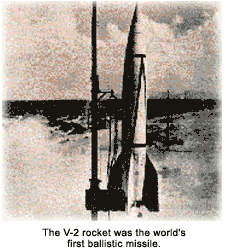 Von Braun returned to Peenemunde after his release, which was orchestrated by Dornberger, who convinced the SS and Gestapo that Hitler would have all of them shot if Von Braun did not complete the V-2 rocket. As the war drew to a close, von Braun asked his staff to whom they wished to surrender. They feared the Russians and preferred Americans. Using forged documents and a stolen train, von Braun led a group of around 500 across Germany until they located an American private and surrendered to him. Many members of von Braun's production team were captured by the Russians. The Americans realized their importance and immediately went to Pennemunde and Nordhausen to take possession of as many V-2s and V-2 parts as possible, for a total of 300 trainloads. They then destroyed the rest with explosives.
Von Braun returned to Peenemunde after his release, which was orchestrated by Dornberger, who convinced the SS and Gestapo that Hitler would have all of them shot if Von Braun did not complete the V-2 rocket. As the war drew to a close, von Braun asked his staff to whom they wished to surrender. They feared the Russians and preferred Americans. Using forged documents and a stolen train, von Braun led a group of around 500 across Germany until they located an American private and surrendered to him. Many members of von Braun's production team were captured by the Russians. The Americans realized their importance and immediately went to Pennemunde and Nordhausen to take possession of as many V-2s and V-2 parts as possible, for a total of 300 trainloads. They then destroyed the rest with explosives.
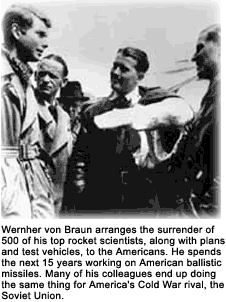 On June 20, 1945, U.S. Secretary of State Cordell Hull approved the transfer of von Braun's German rocket specialists to America. After helping to sift through the Pennemunde documents, they were moved together to Fort Bliss, Texas, just north of El Paso. At first, they were not allowed to leave the base without military escort. At Fort Bliss, they assisted in restoring the V-2s to working condition and gave advice on the future of military and research uses for rockets.
In 1950, von Braun and his team moved to Huntsville, Alabama, where von Braun remained for the next 20 years. At the Redstone Arsenal facility, they developed the Redstone Rocket and later the Jupiter-C Rocket. It was a Jupiter-C that launched Explorer 1, America's first orbiting satellite, on January 31, 1958. Von Braun also found time to cooperate with Walt Disney as the technical director of three Disney television films on the exploration of space. Von Braun felt his involvement with Disney would help propel interest in space exploration for peaceful means.
On June 20, 1945, U.S. Secretary of State Cordell Hull approved the transfer of von Braun's German rocket specialists to America. After helping to sift through the Pennemunde documents, they were moved together to Fort Bliss, Texas, just north of El Paso. At first, they were not allowed to leave the base without military escort. At Fort Bliss, they assisted in restoring the V-2s to working condition and gave advice on the future of military and research uses for rockets.
In 1950, von Braun and his team moved to Huntsville, Alabama, where von Braun remained for the next 20 years. At the Redstone Arsenal facility, they developed the Redstone Rocket and later the Jupiter-C Rocket. It was a Jupiter-C that launched Explorer 1, America's first orbiting satellite, on January 31, 1958. Von Braun also found time to cooperate with Walt Disney as the technical director of three Disney television films on the exploration of space. Von Braun felt his involvement with Disney would help propel interest in space exploration for peaceful means.
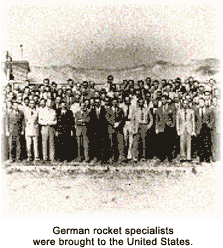 NASA was established on July 29, 1958. Two years later, it opened the Marshall Space Flight Center in Huntsville. Von Braun became the center's first director in July 1960, and he retained that post until February 1970.
The Saturn, America's first rocket capable of launching astronauts to the moon, was soon developed at Marshall. After the Saturn had delivered the first man to the moon, von Braun was instrumental in developing the Saturn 1B, which lifted Skylab, the world's first space station, into orbit. The last use of Saturn was to connect with the Russian Soyuz craft during the historic 1975 Apollo-Soyuz mission.
NASA was established on July 29, 1958. Two years later, it opened the Marshall Space Flight Center in Huntsville. Von Braun became the center's first director in July 1960, and he retained that post until February 1970.
The Saturn, America's first rocket capable of launching astronauts to the moon, was soon developed at Marshall. After the Saturn had delivered the first man to the moon, von Braun was instrumental in developing the Saturn 1B, which lifted Skylab, the world's first space station, into orbit. The last use of Saturn was to connect with the Russian Soyuz craft during the historic 1975 Apollo-Soyuz mission.
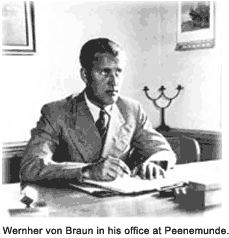 Differences in strategic thinking persuaded von Braun to retire from NASA in 1972. He joined Fairchild Industries as vice president in, appropriately, Germantown, Maryland, where he was active in establishing the National Space Institute. Diagnosed with cancer, von Braun resigned from Fairchild on December 31, 1976. He died on June 16, 1977, in Alexandria, Virginia]. He was survived by his wife, three children, and two brothers.
Differences in strategic thinking persuaded von Braun to retire from NASA in 1972. He joined Fairchild Industries as vice president in, appropriately, Germantown, Maryland, where he was active in establishing the National Space Institute. Diagnosed with cancer, von Braun resigned from Fairchild on December 31, 1976. He died on June 16, 1977, in Alexandria, Virginia]. He was survived by his wife, three children, and two brothers.